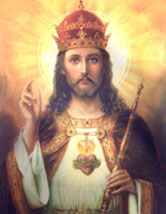 |
|
| |||||||||||||
|
United Religions Back in the Spotlight:
|
|||||||||||||
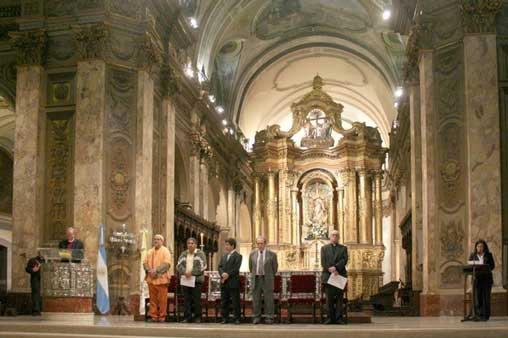 https://uri.org/uri-story/20140313-one-year-backreflections-pope-francis |
|
Buenos Aires Metropolitan Cathedral, May 2007: URI Leaders in Argentina join together with Episcopalian Bishop Swing (at the pulpit) and Cardinal Bergoglio — now Pope Francis — (centre group, right) to celebrate the 10th Anniversary of the URI's first gathering in Latin America. |
Pope Francis should have reminded him of this, especially since the UR was not a new idea for Francis. In 2007, as Archbishop of Buenos Aires, he had invited its founder and head to an interfaith service in his cathedral to celebrate the 10th anniversary of the UR in Latin America.[3] Furthermore, the Holy See has been aware of the United Religions from its conception, and has been working for its goals through its founding partners.
One thus has to wonder: Did Peres and the Vatican have collective Alzheimer’s, or were they confident that most Catholics are ignorant/ suffering amnesia? The history of the United Religions illustrates the extent of their disingenuousness.
The United Religions is created
The Masonic one-world religion of the New World Order, in the making for over 150 years, materialized in June 1997 as the United Religions Organization.[4] Chief partners in its establishment were Episcopal Bishop of California, William Swing; the Communist Gorbachev Foundation/USA (later The State of the World Forum); and the syncretic World Conference on Religion and Peace, now called Religions for Peace (RfP).
Bishop Swing is an anti-population and pro-homosexuality activist. He is a follower of the expelled Dominican and occultist, Matthew Fox, who became an Episcopalian minister under Swing.
Religions for Peace is an internationalist, occult UN Non-Govermental Organization headquartered at the United Nations in New York. It is an important “unofficial” Vatican channel for interreligious activities, said Francis Cardinal Arinze, former head of the Pontifical Council for Interreligious Dialogue. It was co-founded in 1960 by John Cardinal Wright, and its first international president was Archbishop Angelo Fernandes of New Delhi. In 1994 it held the first-ever interfaith conference at the Vatican, with Pope John Paul II its opening speaker.
Many bishops and cardinals have been collaborating with the RfP as Co-Presidents, Honorary Presidents or other officials. These include Peter Cardinal Turkson, President of the Pontifical Council for Justice and Peace (now the Dicastery for Promoting Integral Human Development), who is the one tasked to follow up on Peres’ proposal; and Oscar Andrés Cardinal Rodríguez Maradiaga, the head of Pope Francis’ special advisory group of cardinals.
The Gorbachev Foundation/USA was set up as a Russian intelligence operation at the Presidio, a former military base in San Francisco, months before the dismantling of the USSR. Mikhail Gorbachev is a major coordinator of world governance and a leading proponent of population extermination and the destruction of religion. This Marxist-Leninist met more than once with Pope John Paul and addressed the pontiff and political leaders at the Vatican in 2000.
The United Religions is a United Nations project. Plans for its formation were revealed to world leaders in June 1995 by Bishop Swing at the occult, earth-worshipping interfaith service he was invited to conduct for the UN, celebrating its 50th anniversary. Present at San Francisco’s Episcopal Grace Cathedral were political luminaries and representatives of all religions, including Britain’s Princess Margaret, Anglican Archbishop Desmond Tutu of South Africa, Polish President Lech Walesa, and UN Secretary-General Boutros Boutros-Ghali. Archbishop Renato Martino (Vatican nuncio to the UN) and Archbishop John Quinn of San Francisco also attended — i.e., the Vatican has known of the UR from the beginning.
Patterned after the UN, the UR is meant to be for religions what the UN is for nations: a "permanent gathering center where the world's religions engage in daily prayer, dialogue, and action for the good of all life on this earth," and where they will make peace amongst themselves and "work together for the healing of the earth." Using the “light” of paganism and occultism, it aims to solve the usual social issues.
But more importantly, it’s also “an attempt to bring accountability to the religious forum”. As the world’s religious authority, it aims to wipe out “fundamentalism,” which is blamed for wars and conflicts. Teilhardian Robert Muller, a former UN Assistant Secretary-General and New World Order designer, declared that fundamentalism's "inflexible belief systems" "play an incendiary role in global conflicts." "Peace will be impossible," he said, "without the taming of fundamentalism through a United Religions that professes faithfulness `only to the global spirituality and to the health of this planet.'" This is also the basic theme of the Peres proposal.
The United Religions gets a Charter
 http://uri.org/files/resource_files/PPP.pdf |
In 1996, Bishop Swing called the process of forming the United Religions “The United Religions Initiative 2000”. The name United Religions Initiative (URI) is still being used for the United Religions, although the one-world church became fully functional in 2000.
A "preliminary" charter-writing conference was held in June 1997 at Stanford University, California. The two hundred delegates “predict[ed] they had given birth to a movement as well as a spiritual institution: the United Religions”. Bishop Swing “deputized” them to "tell the people that there is a United Religions."
The URI Charter was finally signed on June 26, 2000, during a six-day Summit in Pittsburg, Pennsylvania, making the one-world church a reality. (June 26th is also the anniversary of the signing of the UN Charter in 1945.) The wording of the URI Charter suggests that “proselytizing” and upholding Christian morality could be considered threats to peace.
This interreligious Summit was opened by native spiritualists invoking “the great spirit,” and closed by a member of the URI Global Counci, who performed a Wiccan “blessing”. He invoked Hecate and Hermes, whilst Bishop Swing raised his hands in invocation. At least eight “highly respected” Catholic priests attended the Summit as supporters. Rev. P. Gerard O’Rourke, Director of Ecumenical and Interreligious Affairs for the Archdiocese of San Francisco, declared he was there in an official capacity.[5]
The URI is headquartered at the Presidio. Its original “satelllite centers” in other cities, including Buenos Aires, seem to have been replaced by "Cooperation Circles." It has built up a wide international network through regional conferences and other activities. Its goal is "A U.N. for religion" that will foster peace. "We are going to end this millennium with peace among religions," said Bishop Swing in 1997. "There is untapped solidarity among religions."
Swing personally pitched the idea of the United Religions to many religious leaders. He got Mother Teresa on board, but posted no report on Pope John Paul’s reaction.
It should be obvious why the Popes cannot openly support the URI; to lead it would be tantamount to sailing the barque of St. Peter under the standard of Satan.
But it may be only a matter of time. At a Theosophical lecture in Boston in 1991, the New England Director of Theosophy described the plan for establishing the one-world religion:
- "Any permanent solution to the Middle East conflict would also have to see the religious portion of the problem solved."
- “The impetus toward this type of settlement is made possible only because of a general fear of war. This fear of war must be maintained until the desired political and religious changes have been instituted.”
- "At the proper moment in history, the Pope will visit the combined Jewish/Christian/Moslem sector of Jerusalem to announce that all religions should be combined into one. This action will then finally break the Middle East logjam”.
Crafting an “epiphany moment”
So what prompted Mr. Peres’ sudden “epiphany” to create a United Religions? It certainly was carefully orchestrated to look spontaneous.
- April 2013: Peres visits Pope Francis six weeks after his election to the papacy. Inviting him to Jerusalem, “the sooner the better,” Peres says, “You have an important role in progressing peace and the belief in it”.[7]
- January 2014: Pope Francis announces he will visit the Holy Land in May.[8]
- February 2014: An Argentinian interfaith group created by Archbishop Bergoglio is sent by Francis to the Holy Land "in anticipation," i.e., to set the stage, so to speak, for his own trip later on. It is greeted in Israel by Peres, who praises the Pope because “he returned religion into a spirit rather than an organization, a faith more than a church”.[9]
- May 2014: Pope Francis visits the Holy Land. In front of the Wailing Wall in Jerusalem he partakes in a group hug with
his two Argentinian travelling companions and syncretist collaborators, Rabbi Abraham Skorka and Muslim leader Omar Abboud. Vatican spokesman Fr. Lombardi enthuses, “They have given us a sign in a significant and holy place. This is an important message, that they can embrace together”.
The Pope also stresses the “universal and cultural significance” of Jerusalem, and its importance to Christians, Muslims and Jews.
He plants an olive tree with President Peres at the presidential palace in Jerusalem.
Before leaving Israel, Francis invites Peres and Palestinian Authority President Mahmoud Abbas to the Vatican for a prayer meeting for Middle East peace.[10]
- Only two weeks later, June 8, 2014, Pentecost Sunday: the two presidents and Ecumenical Patriarch Bartholomew I attend this interfaith prayer meeting on a triangular Vatican lawn, along with several high-up members of Religions for Peace and a former director of the Focolare movement in the Holy Land (the only woman in the Holy See delegation).
Seemingly at the request of Israel, a “neutral” site is chosen, devoid of all religious symbols, as Jews cannot pray in front of a Cross. Further, "Jewish rabbis, Christian cardinals and Muslim Imams read and chant from the Old Testament, the New Testament and the Koran ... in the first such inter-religious event in the Vatican." Catholic participants thus witness to the Masonic one-world religion instead of to Jesus Christ and His Church!
Francis and his three interfaith colleagues plant an olive tree in the Vatican gardens as a sign of peace.[11] - June 9, 2014: Pope Francis criticizes “fundamentalism” in Christianity, Judaism and Islam as violence: "A fundamentalist group, even if it doesn't strike anyone, is violent. The mentality of fundamentalism is violence in the name of God."[12]
- September 4, 2014: Peres shares his “epiphany moment” with the Pope and asks him to head his visionary United Religions. Father Lombardi reveals that this proposal followed from the syncretic June prayer meeting. He says the Pope “stressed to me” that the meeting was “the opening of a door” to encouraging further initiatives “to develop and go forward”.[13]
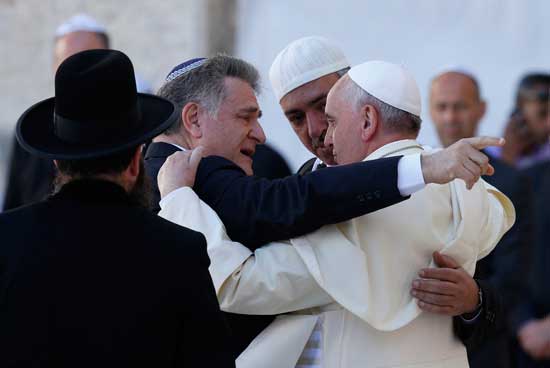 |
Group hug: Pope Francis and his Argentinian syncretist friends, Rabbi Abraham Skorka and Muslim leader Omar Abboud, at the Wailing Wall, May 26, 2014. "We did it," Skorka said he told the Pope and Abboud. (CNS photo/Paul Haring) |
The ubiquitous peace tree
|
|
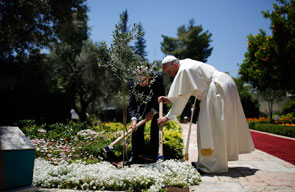 |
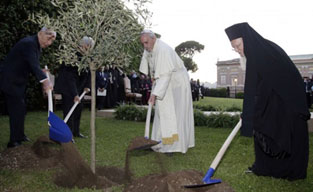 |
Pope Francis and Israel's then-President Shimon Peres plant an olive tree to symbolize peace after their meeting at the president's residence, May 26, 2014. (CNS photo/Amir Cohen, EPA) |
Pope Francis plants an olive tree with Shimon Peres, left, Palestinian President Mahmoud Abbas, second from left, and Ecumenical Patriarch Bartholomew I, right, as a sign of peace, following syncretic peace prayers in the Vatican gardens, June 8, 2014. (AP Photo/Max Rossi, Pool) |
War means success?
It seems the true God was not impressed by the atheistic Vatican prayer meeting on Pentecost Sunday, June 8th, for peace in the Middle East. The area exploded in war right after it.
On July 8th, Israel began a 50-day campaign against Gaza that killed more than 2,000 Palestinians, mostly civilians. Israeli deaths totalled 6 civilians and 67 soldiers.[14]
And at the same time as the Vatican prayer meeting, Islamic militants began a bloody rampage across Iraq, leading three weeks later to the proclamation of a “caliphate” and a call-to-arms of Muslims across the world.[15]
But Fr. Lombardi was very pleased with the success of the Pentecost Sunday prayer meeting. He remarked after the September 4th audience: “The prayer for peace initiative which took place here” with Peres and Abbas, “is in no wise to be considered a failure – subsequent developments notwithstanding – but rather as the opening of a door … through which initiatives and values can be encouraged to develop...."[16]
Considering the massacres that followed the Pentecost Sunday prayer meeting, this callous assessment implies that the Holy See is more devoted to the formation of the one-world religion rather than to actual peace. Indeed, if peace were truly its concern, the peace plan of Our Lady of Fatima would have long ago been carried out.
And what about Nobel Peace Laureate Peres, touted as a “crusader for peace”? About a week after the Gaza offensive began, with 200 Palestinians and one Israeli dead, he defended Israel’s heavy-handed actions: “If they are shooting at us, and don’t let our mothers and their children … have a full night’s sleep, what can we do?”[17]
But he need not have worried. The One-World Church now has official papal blessing. Surely peace will follow swiftly.
RELATED: Pope Francis Encourages the One-World Church
ENDNOTES
1. Emily Shapiro, “Former Israeli President Peres Meets with Pope, Proposes UN for Religions,” abcnewsradioonline.com/world-news/former-israeli-president-peres-meets-with-pope-proposes-un-f.html, 4 September, 2014.
2. Carol Glatz, “Peres: Pope Francis is Only Leader Respected Enough to End Today's Wars,” https://www.ncronline.org/news/world/peres-pope-francis-only-leader-respected-enough-end-todays-wars, 4 September 2014; Marco Tosatti, “Peres’ Proposal to Francis to Set Up a UN of Religions,” https://www.lastampa.it/2014/09/04/vaticaninsider/peres-proposal-to-francis-to-set-up-a-un-of-religions-nqnTVfJaJ2WQlT1kVCPPKM/pagina.html.
3. Bishop William E. Swing, uri.org/uri-story/20130918-my-house-shall-be-house-prayer-all-people, 18 September 2013; Maria Eugenia Crespo de Mafia, uri.org/uri-story/20140313-one-year-backreflections-pope-francis, 13 March 2014.
4. Unless otherwise indicated, details of the UR’s history are taken from our articles, “One-World Church Expected Next Year,” “One-World Church Starts Up,” and “Pope Francis Encourages the One-World Church?”, in, respectively, the October 1996, November 1997 and June 2014 issues of Catholic Family News; and “The One-World Church Emerges,” Homiletic & Pastoral Review, January 1999.
5. Carl Teichrib, “Blending of the Gods: The United Religions Initiative Global Charter Signing,” www.inplainsite.org/html/united_religions_initiative.html#URI4.
6. “Complete Seminar Notes From House of Theosophy Seminar…,” cuttingedge.org/news/n1052.html. Theosophy is a cornerstone of the New Age, preaching the evolution of the universe to godhood. The Masonic Theosophical Society was founded by Russian occultist and New Age Movement creator Helena Blavatsky in New York in 1875.
7. Cindy Wooden, “Israeli President Invites Pope to Visit Israel, ‘the Sooner the Better,’” https://www.ncronline.org/news/world/israeli-president-invites-pope-visit-israel-sooner-better, 1 May 2013.
8. Kerri Lenartowick, catholicnewsagency.com/news/pope-francis-announces-pilgrimage-to-holy-land/, 5 January 2014.
9. Jorge Rouillon, "Pope Francis' Holy Land Partners in Faith," http://www.ncregister.com/daily-news/pope-francis-holy-land-partners-in-faith, 23 May 2014; Claudia Peiró, "Pope Francis Received the Interreligious Group of Argentines who Visited the Holy Land," Google translation of https://www.infobae.com/2014/02/27/1546822-el-papa-francisco-recibio-al-grupo-interreligioso-argentinos-que-visito-tierra-santa/; Shiryn Ghermezian, algemeiner.com/2014/02/23/peres-praises-pope-francis-in-meeting-with-argentinian-interfaith-leaders/.
10. William Booth and Ruth Eglash, washingtonpost.com/world/pope-francis-balances-time-with-israelis-and-palestinians-during-visit-to-holy-land/2014/05/26/c39b126c-e4d5-11e3-afc6-a1dd9407abcf_story.html; Francis X. Rocca, “On Last Morning in Holy Land, Pope Reaches out to Muslims, Jews,” https://www.catholicnews.com/services/englishnews/2014/on-last-morning-in-holy-land-pope-reaches-out-to-muslims-jews.cfm, 26 May 2014.
Rabbi Skorka is head of the Latin American Rabbinical Seminary in Buenos Aires. Dubbed "the pope's rabbi," he has been involved in many syncretic activities with Francis, including co-writing the book, On Heaven and Earth, about theological issues facing Christianity, Judaism and modern society: Jeremy Sharon, jpost.com/National-News/Rabbi-Avraham-Skorka-to-accompany-Pope-Francis-353148, 23 May 2014. In September 2013, Skorka revealed he would be visiting the Holy Land with the Pope in 2014. "I dream of embracing him at the ... Wailing Wall," he said, thus accounting for his widely-reported comment to Francis at the group-hug, "We did it!": Gerard O'Connell, "Pope Francis and Rabbi Skorka Make History in the Vatican," vaticaninsider.lastampa.it/en/the-vatican/detail/articolo/francesco-francis-francisco-28206/, 29 September 2013.
Omar Abboud is a former secretary general of the Islamic Center of Argentina. Currently, he is the secretary general of the Argentine Institute of Interreligious Dialogue, which he co-founded in 2001 with Cardinal Bergoglio's spokesman, Father Guillermo Marcó, and Rabbi Daniel Goldman, at Bergoglio's urging. It was these three Institute founders who, "encouraged by Francis," visited the Holy Land with other interfaith leaders in February 2014 "as an anticipation" of the Pope's own journey: Rouillon, ibid. Note that Francis himself is considered a co-founder of the Institute and a "close collaborator" of the three partners, who in 2018 were honored speakers at an interfaith conference held by, and studded with occultists: http://dawnofinterspirituality.org/media/; "Dawn of Interspirituality" flyer, http://www.satyana.org/pdf/Dawn%20Flyer%20III%20FINAL.pdf.
Francis is a revered New Age leader. Largely through his efforts, his native Argentina is seen as a model of the planned peaceful one-world State of the New World Order. Making him head of the URI would be merely an official recognition of his interfaith leadership. See Claudio Epelman, "Interreligious Coexistence is Possible and Argentina is Proof of This," https://www.kaiciid.org/news-events/news/claudio-epelman-%E2%80%9Cinterreligious-coexistence-possible-and-argentina-proof-%E2%80%9D, 27 June 2016; Gerard O'Connell, "Pope Francis as Interreligious Leader," https://www.americamagazine.org/issue/interreligious-leaders, 19 January 2016; Elisabetta Piqué, "Pope's Support for the Creation of an Interreligious Dialogue Institute Linked to the OAS" (Google translation), https://www.lanacion.com.ar/1844935-apoyo-del-papa-a-la-creacion-de-un-instituto-de-dialogo-interreligioso-vinculado-a-la-oea, 13 November 2015.
11. "Vatican: RfP Leaders Demonstrate Solidarity for Vatican Invocation for Peace," Religions for Peace Global Newsletter, June 2014, p. 4, religionsforpeace.org/sites/default/files/pubications/FINAL%20NEWSLETTER.pdf; Andrea Gagliarducci, https://www.catholicnewsagency.com/news/arab-christian-witnesses-grace-of-popes-prayer-for-peace-28894, 11 June 2014; english.alarabiya.net/en/News/middle-east/2014/06/06/Islamic-prayers-to-be-held-at-the-Vatican.html; Abdallah Schleifer, http://english.alarabiya.net/en/perspective/analysis/2014/06/09/Pope-Francis-brings-together-Imams-and-Rabbis-at-the-Vatican.html; Philip Pullella; “Pope says Israelis, Palestinians must seek peace ‘undaunted in dialogue,’” reuters.com/article/2014/06/08/us-pope-mideast-idUSKBN0EJ0G720140608; https://www.archons.org/-/ecumenical-patriarch-bartholomew-joins-pope-francis-at-a-vatican-invocation-for-peace.
12. “Full Text of Pope Francis’ Interview …,” catholicnewsagency.com/news/pope-francis-interview-with-la-vanguardia---full-text-45430/, 13 June 2014.
13. thechurchinmalta.org/en/posts/45084/peace,-dialogue-at-centre-of-audiences-with-peres-and-hassan, 5 September 2014.
14. Kershner, “Israel to Probe Five Incidents of Possible Military Misconduct,” The Globe and Mail (Toronto), 11 September 2014, p. A11.
15. Yara Bayoumy, “‘Caliph’ Calls on all Muslims to Take up Arms,” ibid., 2 July 2014, p. A8.
16. See note 13.
17. Dan Perry, timesofisrael.com/peres-defends-idf-airstrikes-on-gaza/, 15 July 2014.
Originally published in Catholic Family News, October 2014.
Updated and expanded for The Catholic Inquisitor under the title "Francis Picked to Lead the One-World Church," February/March 2019.
Online version expanded and revised, October 2018; last updated April 2019.
Copyright © 2008-2025 Canisius Books. All rights reserved.
Users may download and print, or electronically distribute, this article or extracts for their own personal and non-commercial use only. For electronic distribution, this web page URL must be acknowledged by hyperlink:
https://canisiusbooks.com/pope-francis-to-lead-one-world-religion.htm